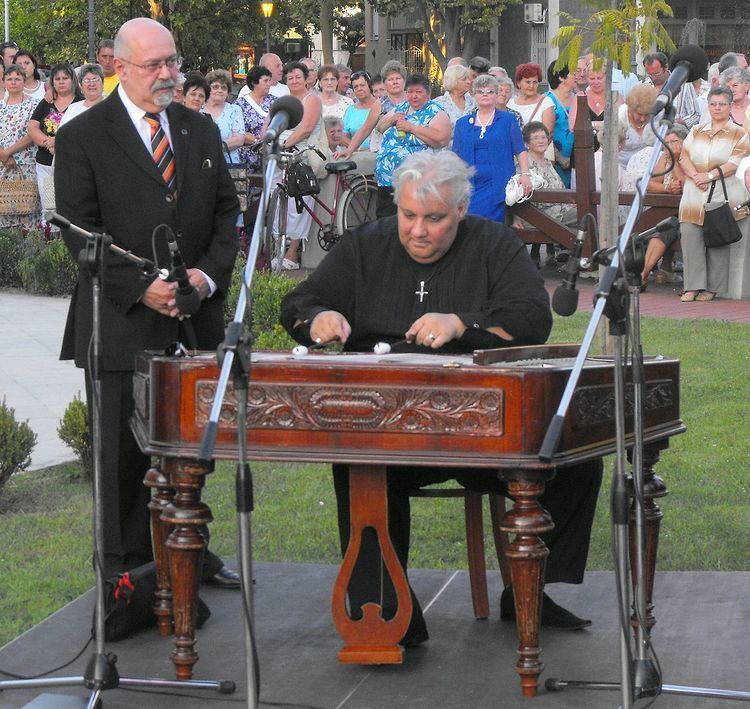 | ||
There are several overlapping schemes for the classification of percussion instruments.
Contents
- By means of sound production
- HornbostelSachs
- The term percussion in HornbostelSachs
- Other systems
- Pitched and unpitched
- By tradition
- Orchestral percussion
- Other criteria
- References
These schemes are based on four types of criteria:
Percussion instruments vary enormously in nature and usage, and have possibly the longest history of any group of musical instruments. For these and other reasons their classification proves difficult, and different classification systems are used in different contexts.
At the highest level of grouping, authorities differ over whether stringed instruments such as the hammered dulcimer and keyboard instruments such as the celesta are percussion instruments, let alone the piano which is both stringed and a keyboard and yet sometimes also termed percussion.
Hornbostel–Sachs does not use the term percussion as a general grouping at all, but instead in a very different sense to the common usage. Instruments such as castanets and cymbals used in pairs are not percussion in the Hornbostel–Sachs sense, but are percussion instruments in every other sense.
Similar problems are encountered at lower levels of classification.
By means of sound production
Ancient Chinese and Indian systems of classification were based on the materials of which the instruments were constructed, and the acoustic properties of the instruments, respectively.
In the 14th century Jean de Muris produced a classification system which divided all musical instruments into three classes: Percussion, String and Wind. Hornbostel–Sachs further develops this scheme, but abandons the percussion high-level grouping, replacing it by the groups idiophones and membranophones.
Hornbostel–Sachs
Hornbostel–Sachs classifies musical instruments by means of a numerically labelled inverted tree structure, originally with four groups at the highest level, two of which are percussion instruments (as the term percussion is normally understood), and the others strings and wind. The system does use the term percussion but at a much lower level in the tree and in an esoteric sense quite unlike its common usage, see below.
Some of the important percussion groupings are:
For a complete list of idiophone classes see:
Hornbostel–Sachs does not distinguish between pitched and unpitched instruments at any level.
The term percussion in Hornbostel–Sachs
It should be particularly noted that this classification does not use the term percussion in its high level grouping, but instead in an esoteric sense, so that other instruments such as the clarinet that are not percussion in any normal sense are described as percussion reeds.
Having no explicit category for percussion as normally understood, Hornbostel–Sachs places nearly all percussion instruments in the high level categories of membranophones (high-level category 2, drums and similar) and idiophones (high-level category 1, cymbals, bells, xylophone-like instruments and similar). A few instruments that are sometimes considered percussion are classified as chordophones (high-level category 3, such as the hammered dulcimer) and as aerophones (high-level category 4, such as the samba whistle). Conversely, the members of the Hornbostel–Sachs high-level categories 1 and 2 nearly all fall clearly or loosely into the conventional category of percussion.
Hornbostel–Sachs does use the term percussion to divide the third-level category directly struck idiophones (111) into percussion idiophones (111.2), those beaten with a hand or beater, such as a suspended cymbal, and concussion idiophones (111.1), those beaten together in pairs such as clash cymbals. The term is also used in a loosely related way to divide reed aerophones (422) into single reed instruments (422.2) with a single 'reed' consisting of a percussion lamella (our emphasis) and double reeds (422.1) also called concussion reeds.
Other systems
Several older systems divide instruments into two high-level classes:
This system was developed by André Schaeffner into a comprehensive classification scheme in 1932.
Pitched and unpitched
Percussion is traditionally divided into pitched percussion, which produces a sensation of pitch, and unpitched percussion, which does not. Some instruments, such as bells, are commonly used in both roles.
The traditional terms tuned percussion and untuned percussion have fallen from favour, replaced loosely by the terms pitched and unpitched, see Unpitched percussion instrument#Untuned percussion.
By tradition
By far the most common way of classifying percussion is by the style or tradition with which it is most closely associated.
Orchestral percussion
An orchestral percussion section is traditionally divided into:
Keyboard instruments such as the celesta are not normally part of the percussion section, as the playing skills required are significantly different.
Other criteria
Some percussion instruments may be classified according to the material of which they, or their sounding component, are constructed. In this way some idiophones for example are sometimes grouped together as metallophones and others as lithophones.
This scheme does not have any wider acceptance, to the point that some terms that might be used in such schemes have meanings in general usage that are inconsistent with it. For example, the serpent is a brass instrument although composed of wood, while many gongs and some cymbals are composed of brass but are not brass instruments, and the modern orchestral flute is a woodwind instrument although composed of silver and/or other metals.
